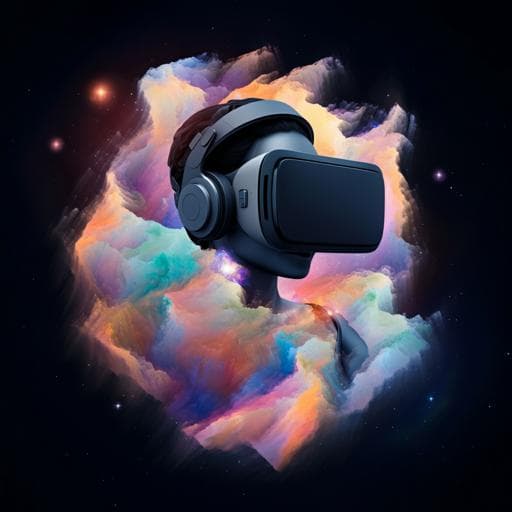
Education
Enhancing multimodal output in CLIL education: the impact of VR games on fourth-grade students' English poster designs and presentations in Taiwan
C. Lai
This study by Cheng-Ji Lai explores the transformative power of VR games in enhancing fourth-grade students' English skills through innovative poster designs and presentations, significantly outperforming traditional methods. Discover how virtual reality is revolutionizing learning in CLIL contexts!
~3 min • Beginner • English
Introduction
The study addresses challenges in CLIL science education where EFL learners often develop receptive skills more than productive skills (speaking, writing), and face higher cognitive load when learning abstract disciplinary content in an L2. In Taiwan’s shift toward CLIL, productive skills remain difficult due to teacher constraints and cognitive demands. Multimodal input and digital tools, particularly VR games, are proposed to mitigate these issues, yet their impact on multimodal output (writing and speaking) in CLIL science is underexplored. Grounded in self-regulated learning (SRL) theory, this study examines whether VR-based review games, rich in multimodal input (text, visuals, audio, interaction), can enhance students’ ability to express scientific concepts in multimodal artifacts (posters) and oral presentations. Research questions: (1) Do VR review games, compared to PPT-led reviews, enhance the textual and graphical composition of English posters (Content, Communication, Cognition, Culture) via 4Cs assessment? (2) Do VR-based review games improve the quality of English poster presentations on the 4Cs compared to PPT-led reviews? (3) How do expert raters perceive the influence of VR vs PPT review games on multimodal output (textual, graphical, oral) in poster creation and presentations?
Literature Review
The theoretical framework is self-regulated learning (SRL), a social-cognitive process in which learners plan, monitor, and regulate cognition, behavior, and motivation. Prior studies show SRL strategies enhance EFL speaking and writing in technology-enhanced contexts, highlighting benefits of strategic planning, feedback use, and emotion in writing and speaking development. Game-based virtual reality learning environments (VRLEs) integrate gamification (points, challenges, narratives) with immersive interaction to promote engagement, exploration, and motivation. Evidence from VR and spherical video-based VR studies indicates improvements in writing performance (thematic coherence, structural integrity, linguistic expressiveness) and, in 3D virtual worlds, gains in L2 speaking (fluency, pronunciation, language use). However, applications within CLIL and effects on multimodal output are limited. Multimodal assessment literature emphasizes evaluating learning through multiple semiotic modes (text, visuals, audio, gestures) and, in CLIL, aligning with the 4Cs (Content, Communication, Cognition, Culture). Studies show triangulating modalities yields more accurate interpretations of science understanding, especially for English learners. This study addresses the gap by comparing VR-based vs PPT-led review games on CLIL students’ multimodal output using 4Cs-guided assessments.
Methodology
Design: Quasi-experimental comparative case study with mixed methods. Participants: 81 fourth-grade students (ages 9–10) from three Taiwanese public elementary schools in CLIL science. Two classes assigned to experimental group (EG=40; EG1:22, EG2:18) using VR-based review games; two to control group (CG=41; CG1:22, CG2:19) using PPT-led review games. All native Mandarin speakers with 3.5 years of English immersion. Pre-intervention equivalence: listening/speaking comparable (t=1.895, p=0.092); no significant differences in science vocabulary (t=1.035, p=0.304) or content knowledge (t=1.761, p=0.082). Power analysis indicated ~34 per group sufficient for medium effect with 80% power; actual n met this. Instruction: Weekly two-period CLIL science curriculum in English. Across five consecutive units, first period delivered content; second period delivered a 20–25 min review session (EG: VR; CG: PPT). Identical content across groups ensured comparability. Interventions: PPT review games employed gamification (points/bonuses/challenges), 20–25 interactive 5W questions per session, multimodal inputs (English word/definition, Chinese translation, images; diagrams; animations; varied question types; repetition; humorous/engaging visuals; random scoring). VR review games (CoSpaces Edu Pro) adapted identical questions into 3D, included: headset training and buddy system; initial and in-game information boards combining graphics and text; avatar audio explanations; interactive hotspots to access vocabulary/content; sequential navigation with timed levels and feedback; identical content coverage; engaging topic-aligned environments; narrative and bonus objectives (e.g., Racoon King, trash pickup). Assessments: Multimodal artifacts (poster designs) and oral poster presentations assessed with 4Cs-based rubrics (six-point scale, 0–5) developed/validated by two CLIL experts. Posters: groups of 3–5 created 20 posters total (10 EG, 10 CG; 4 per unit across classes). Students received a uniform 20-min poster-design training; instructed to rely only on classroom learning (no external resources). Presentations: 20 group presentations (2–4 min) two weeks later; 20-min training on presentation skills; recorded for analysis. Raters: two of three instructors scored posters and presentations, comparing matched EG/CG artifacts within the same unit. Interrater reliability: mostly perfect (1.0). Exceptions: posters—CG Communication–sentence complexity kappa=0.859, CG Culture kappa=0.853; presentations—CG Cognition kappa=0.853. Analyses: Independent-samples t-tests (SPSS v25), alpha=0.05, two-tailed, reporting means, SDs, t, p, Cohen’s d. Qualitative rater reflections collected post-scoring and analyzed thematically to interpret how review experiences influenced multimodal outputs. Procedure timeline: Weeks 2–6 instruction and reviews; Weeks 8–9 poster creation; Week 10 presentations; Week 11 assessments and reflections. Ethics: Institutional ethics approval; parental consent obtained.
Key Findings
Posters (4Cs rubric; group-level scoring shared by group members): • Content: EG higher (M=3.60, SD=1.046) vs CG (M=2.70, SD=1.302), t=2.410, p=0.021, d=0.76. • Communication: target vocabulary usage EG 4.40 vs CG 4.10, t=0.896, p=0.376, d=0.28 (ns); sentence length EG 2.60 vs CG 2.20, t=0.872, p=0.389, d=0.28 (ns); sentence complexity EG 1.50 vs CG 1.65, t=-0.578, p=0.566, d=-0.18 (ns); grammar accuracy EG 2.00 vs CG 1.60, t=1.566, p=0.126, d=0.49 (ns). • Cognition: EG higher (M=3.70, SD=0.923) vs CG (M=2.40, SD=1.142), t=3.958, p=0.000, d=1.25. • Culture: EG 1.80 vs CG 1.55, t=0.717, p=0.478, d=0.23 (ns). Presentations (4Cs rubric): • Content: EG higher (M=3.60, SD=0.681) vs CG (M=3.10, SD=0.718), t=2.260, p=0.030, d=0.71. • Communication: target vocabulary usage EG 4.20 (SD=1.005) vs CG 3.20 (SD=0.768), t=3.536, p=0.001, d=1.12; sentence length EG 1.90 (SD=1.071) vs CG 1.40 (SD=0.503), t=1.890, p=0.066, d=0.60 (ns); sentence complexity EG 1.20 (SD=0.410) vs CG 1.00 (SD=0.000), t=2.179, p=0.036, d=0.69; grammar accuracy EG 1.40 (SD=0.681) vs CG 1.20 (SD=0.410), t=1.125, p=0.267, d=0.36 (ns). • Cognition: EG higher (M=3.70, SD=1.129) vs CG (M=2.35, SD=0.875), t=4.228, p=0.000, d=1.34. • Culture: EG 1.30 (SD=1.302) vs CG 1.20 (SD=0.410), t=0.328, p=0.745, d=0.10 (ns). Rater reflections: • Posters—Content and Cognition: EG integrated VR-derived visuals and concepts (e.g., animals/plants from VR scenes, water-cycle elements, Maslow’s hierarchy) showing deeper understanding, application, and cross-unit connections; CG leaned more on text and recall-level visuals. • Presentations—Content/Communication/Cognition: EG used more precise scientific terminology, more complex structures, deeper explanations (e.g., atmospheric gas distribution, wind creation, water resource percentages), and higher-order cognitive processing; CG often listed answers with simpler language and lower cognitive demand. Overall: VR-based review games significantly enhanced Content and Cognition in both modalities (posters and presentations), improved Communication in presentations (vocabulary and sentence complexity), and showed no significant differences in Culture.
Discussion
Findings across both artifacts indicate that VR review games, through rich multimodal input (graphic-text information boards, avatar audio explanations, interactive hotspots), immersive environments, and collaborative buddy systems, supported better content retention, deeper conceptual understanding, and higher-order cognitive processing. The significant gains in Content and Cognition address RQ1 and RQ2, evidencing that VRLEs foster analysis, application, and cross-unit integration beyond recall emphasized in PPT-led reviews. Communication gains in presentations (higher target vocabulary usage and sentence complexity) suggest VR’s interactive scaffolds and repeated exposure to disciplinary language promoted more sophisticated oral language use, even if sentence length and grammar accuracy did not significantly differ. Culture did not differ between groups, likely because both VR and PPT interventions focused on scientific targets with limited cultural content. The results align with and extend prior VR literature by showing not only language gains but also robust improvements in higher-order cognition within CLIL, and they illustrate how SRL processes (forethought planning via instructions/boards, behavioral regulation via buddy system, motivational engagement via gamified feedback and narratives) likely mediated these improvements.
Conclusion
Empirically, the study demonstrates that game-based VR learning environments substantially enhance CLIL fourth-graders’ multimodal output in Content and Cognition for both posters and oral presentations, and improve Communication in oral presentations (vocabulary usage and sentence complexity). Methodologically, it showcases multimodal assessment using the 4Cs to capture written and oral outcomes, combining quantitative t-tests and qualitative rater reflections for robust triangulation. Theoretically, it extends SRL applications in CLIL by showing how VRLE features scaffold strategic, cognitive, and motivational dimensions, fostering advanced cognitive skills (application, evaluation, cross-unit integration). Future work should deliberately embed cultural content within VR to cultivate cultural awareness, broaden contexts and samples (ages, settings), and examine long-term impacts of VRLEs on multimodal learning.
Limitations
Limitations include a relatively small, context-specific sample (Taiwanese fourth-grade CLIL science), which constrains generalizability; emphasis on cognitive/content outcomes with limited affective, social, and cultural focus; potential observer bias in qualitative reflections; absence of longitudinal follow-up to assess durability of effects; and lack of a public project website for broader dissemination of game materials. Future research should involve larger and more diverse samples, incorporate explicit cultural elements in VR, investigate affective and social dimensions (motivation, collaboration), employ longitudinal designs, and use additional objective analytics (e.g., eye-tracking, interaction logs).
Related Publications
Explore these studies to deepen your understanding of the subject.







